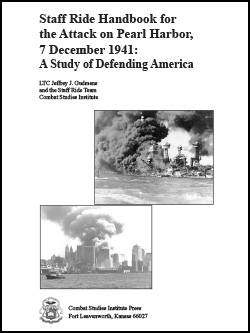
A Study of Defending America
By LTC Jeffrey J. Gudmens and the Staff Ride Team Combat Studies Institute
176 Pages
Published: 2005
The Pearl Harbor Staff Ride Handbook is the ninth study in the Combat Studies Institute’s (CSI’s) Staff Ride Handbook series. LTC Jeffrey Gudmens’ handbook on Pearl Harbor allows individuals and organizations to study this battle not only in the context of the Japanese attack but, more importantly, in the context of issues that are relevant to the current global war on terror. In addition to analyzing the actual attack, Gudmens also enables users of this work to examine the problems associated with conducting joint planning and operations between the US Army, the Army Air Forces, and the US Navy.
He also provides insights into the problems of a Homeland Security environment in which intelligence operatives from a foreign nation (and potentially even recent immigrants from that foreign nation who are now US citizens) can operate with little hindrance in a free and open democratic society. Additionally, this study provides an opportunity to look at how military commanders and planners prepared for their wartime mission with inadequate resources and equipment. Each of these issues, and others analyzed herein, is as relevant to us today as it was almost 65 years ago. Modern military professionals for whom this handbook was written will find a great deal to ponder and analyze when studying the events leading up to, and including, the attack on Pearl Harbor.
Download the PDF 